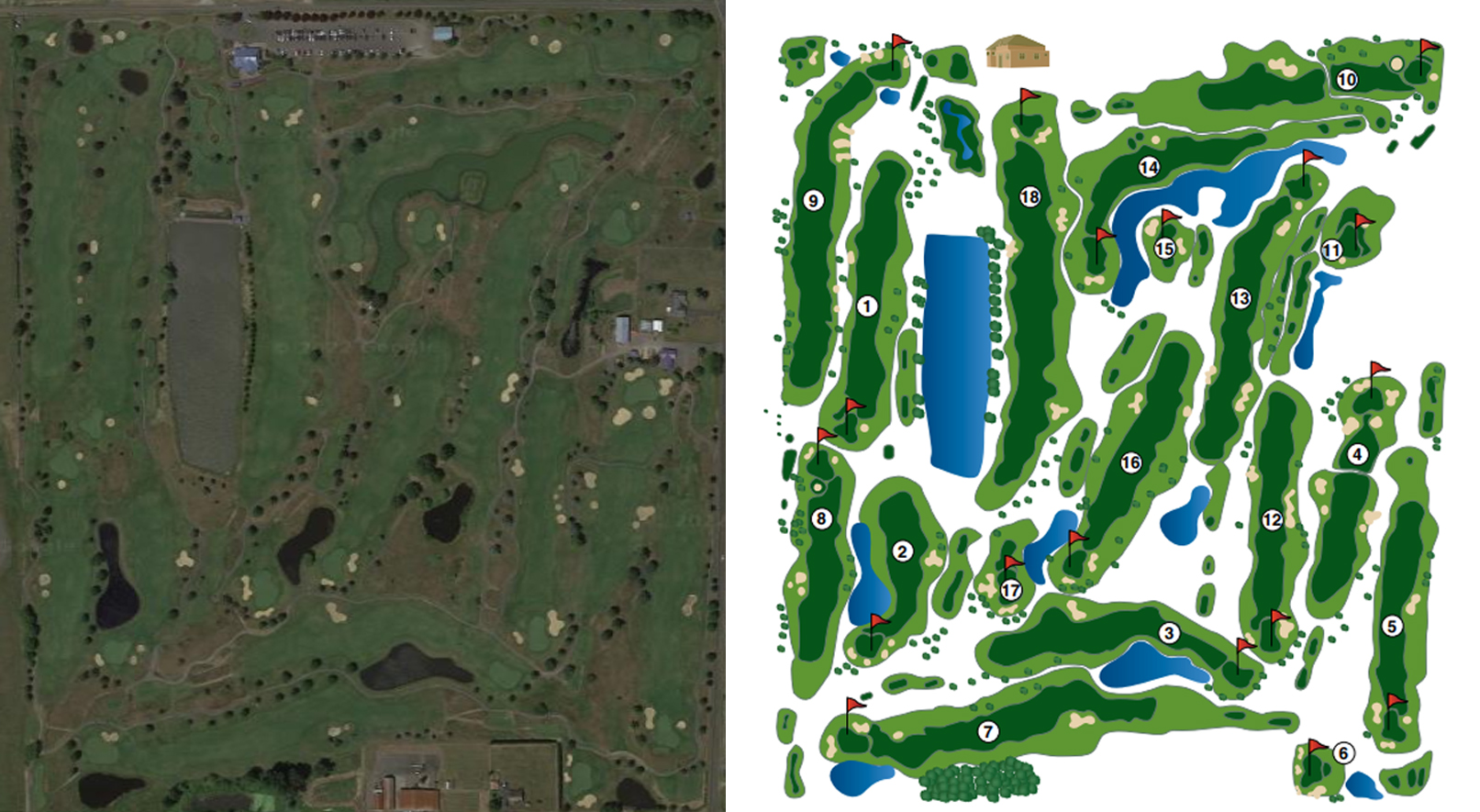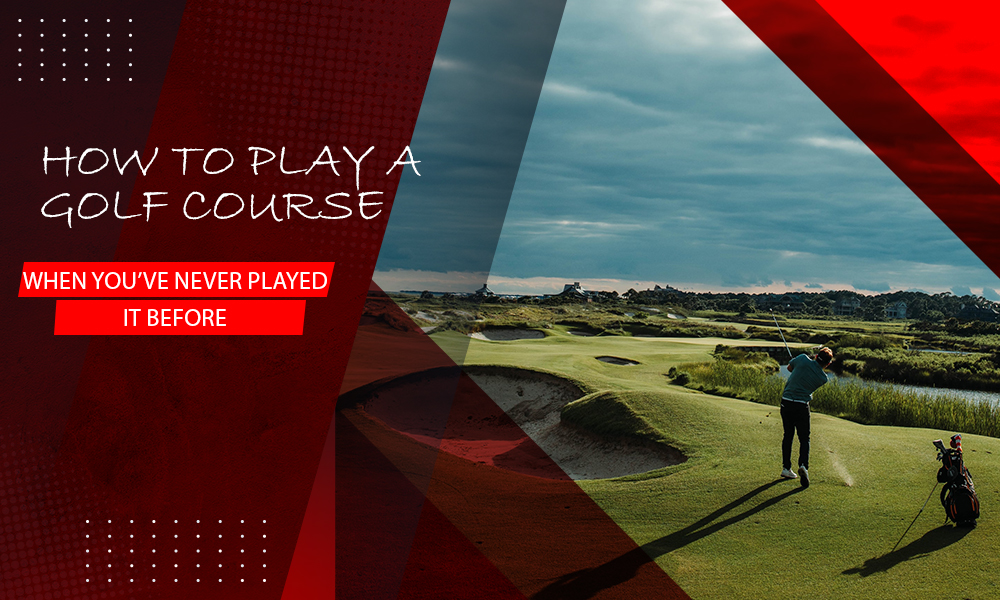One of the things I enjoy most about golf is checking out all the courses out there. It gives you a chance to experience unique course designs, scenery, practice facilities, restaurants, and more.
However, as enjoyable as playing a new golf course is, it’s also hard. When you’ve never played a golf course before, you’re not familiar with all the little nuances.
- The best lines to take
- Where to layup
- Yardages to hazards
- The undulations on each green
- How to play the course with your shot shape
So, how do you play a golf course for the first time?
One option is to wing it. This is a rough way to play a course for the first time, though, especially if you plan to keep score.
There are much better ways to play a golf course for the first time – and in such a way that you still have a chance to score well.
Google Earth – The Best Way to Study a Golf Course
The best way to prepare for a golf course you haven’t played before – other than perhaps walking the course, which is usually not an option – is to study it using Google Earth.
Google Earth is a program that provides a 3D rendering of a location using satellite imagery and aerial photographs. It will show you just about everything you can expect to find on the golf course – tee boxes, hazards, out-of-bounds, trees, etc.
Google Earth also has a ruler. You can use this to measure the distance from the tee box to various hazards or locations on the course to determine what club you should hit off the tee. You can then figure out what you might want to use for your second shot and third shot on par 5s. I also use the ruler to measure the widths of different parts of the fairway to determine whether hitting driver makes sense and good spots to lay up to.
In fact, Google Earth is perfect for mapping out a general strategy for any course you play, whether you have played there before or not.
Keep in mind that you will want to try to get your hands on the golf course’s scorecard before you attempt to use Google Earth. That way you know which holes you’re taking notes on (#1, #2, etc.). If you’re unable to do that, you should find another way to label them so that you can still use the info on the course.

Warning! Google Earth is Not Perfect
Google Earth is my favorite way to prepare for a golf course I have never played, but it does have its limitations.
For example, most golf courses move their tee boxes. Google Earth won’t show the location of each tee box, so the measurements you take off the tee are no more than estimates.
You also won’t know for sure how tall any of the trees are. While you don’t want to hit from a forest of trees, some are easier to recover from than others due to the type of trees, number of branches, height, etc. This is hard if not impossible to gauge using Google Earth.
Another thing you won’t be able to see in Google Earth are elevation changes. Most if not all golf courses will look flat on Google Earth. This could lead to quite a shock when you get to the course and realize that there are unique elevation changes you will need to adjust for – perhaps even hit from.
All that said, Google Earth is still the best way I know of to study for a golf course you’ve never played before. You can get a good idea of what to expect before you ever step foot on the property, which should help you play the best golf you can given the circumstances.
More Help to Score Well on a Course You’ve Never Played
There are other tools you’ll want to consider using if you want to score well on a course you’ve never played before – even if you took the time to map out your course strategy using Google Earth.
And if you didn’t? Well, the following options might just help you salvage the round.
GPS Watch
A GPS watch from the likes of Shot Scope or Garmin is probably the next best thing to Google Earth. Golf GPS watches will give you data like this:
- Distance from tee to greens
- Approach distances to the greens including to the front, middle, and back
- Distances to each hazards
- Layup distances for each hazard
This data will enable you to navigate the course even if you’ve never played there before. This data usually comes from satellite GPS too, so you know it’s pretty darn accurate.
Many GPS watches come with shot tracking too, if collecting data on various aspects of your golf game is something you’re interested in.
It’s possible you can find a GPS golf watch with slope / elevation information too. I just can’t comment on the best models as I’ve not used any yet.
Rangefinder
Of course, you don’t need to buy a GPS watch with slope / elevation if you have a rangefinder that provides that information. My rangefinder – the Voice Caddie SL2 – has that feature and many others. It’s the Cadillac of rangefinders.
What I like about it is that you can get the distance to the pin or another location, and you’ll get the adjusted yardage based on whether you’re taking a shot uphill or downhill.
Of course, you don’t need to spend money on those features if you don’t need them. All you absolutely need is a rangefinder that will give you distances from point A to B – such as the distance from the tee box to a dogleg – which is something most golf watches can’t do.
Even if you’ve scouted a golf course using Google Earth, I still think it’s imperative you use a rangefinder. This will give you the most accurate distances on the course and will help ensure you choose the best targets from your current location based on the hazards in front of you and your shot shape.
Caddy or Friend
Another option for playing a new golf course is to bring a friend that has played it before and/or hire a caddy. Having information about where to aim, what to avoid, etc. is so much better than going it alone.
Yardage Books
Many golf courses offer yardage books. These will give you yardages to bunkers, water hazards, greens, etc. Some yardage books will even give you distances to sprinkler heads.
The neat thing about yardage books is that you can add notes to them so that you can have even more information the next time you play the course.
These are relatively cheap at $10-$20 each, which can save you a bit of time from using Google Earth to figure out how to approach a new golf course.
Consider Playing Forward Tees
You might also consider playing the forward tees. Now, if you already play the whites then you might not need to move forward. But if you play the blacks or the blues, playing a closer tee might help you have closer approach shots – think wedges instead of long irons or hybrids – which should help you hit more greens – especially if you aim for the middle of the greens.
Final Pieces of Advice for Playing a New Golf Course
I’ve given you my best advice for learning how to play a golf course for the first time. Google Earth is hands down the best way to scout a golf course before stepping foot on the property. And using a GPS watch or, at the very least, a rangefinder will help fill in any missing gaps.
Doing at least one of the following will get you far. Doing more than that will get you nearly all the way there – about as far as you can get without having first hand experience.
All that will be left is to practice some putts if possible before your round starts. I recommend you roll several putts from many different locations and distances to get a good feel for the green speeds.
You might also ask the course pro or management for any advice for how to approach the course. Odds are they can give you some pointers to help you avoid some easy mistakes.
The final thing I’ll leave you with is this – consider not keeping score the first time you play a course. Keeping score will add some unnecessary stress that you might not otherwise feel if you were to have some experience playing the course. Then, once you get a round or two under your belt, then start keeping score.
However, if you want to or must keep score, then at least the tips above should help you score well on just about any course you’ve never played before.

